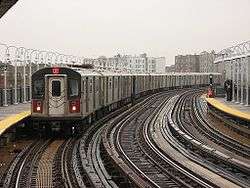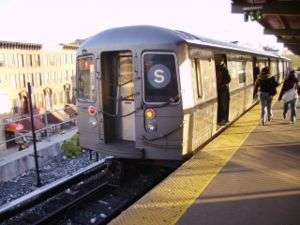Deck Roof (New York City Subway car)
| Deckroof Hi-V | |
|---|---|
| In service | 1907-1958 |
| Manufacturer | American Car and Foundry |
| Constructed | 1907-1908 |
| Number built | 50 |
| Number preserved | 1 |
| Number scrapped | 49 |
| Formation | Singles |
| Fleet numbers | 3650-3699 |
| Operator(s) |
Interborough Rapid Transit Company NYC Board of Transportation New York City Transit Authority |
| Specifications | |
| Car body construction | Riveted Steel |
| Car length | 51 ft 1.5 in (15.58 m) |
| Width | 8 ft 10 in (2,692 mm) |
| Height | 12 ft 0 in (3,658 mm) |
| Doors |
Up until the early 1910s: 4 After the 1910s: 6 |
| Maximum speed | 55 mph (89 km/h) |
| Weight |
Motor car: ~83,780 lb (38,002 kg) |
| Traction system | Motor car: 2 motors per car. |
| Power output | 200 hp (149 kW) per traction motor |
| Electric system(s) | 600 V DC Third rail |
| Current collection method | Contact shoe |
| Braking system(s) |
Before 1910: WABCO Schedule AM(P) with 'P' type triple valve and M-2 brake stand After 1910: WABCO Schedule AMRE with 'R' type triple valve and ME-21 brake stand |
| Track gauge | 4 ft 8 1⁄2 in (1,435 mm) |
The Deck Roof Hi-V, a New York City Subway car, was built between 1907 and 1908. These cars remained in service from 1907 to 1958 and were also nicknamed the Battleships.
When they were new, they had two doors on each side until the early 1910s, when they received another door in the middle on each side.[1] Just like the Gibbs cars, the Deck Roofs sent 600 volts into the controller, which was hazardous, but with that exception these cars proved to be reliable throughout their career.
In the 1920s the Hi-V fleet was being converted to multiple unit door control, with exception being all 50 of the Deck Roofs and some Gibbs and Hedley cars. The Deckroofs were often placed at either end of the train so that ten car trains of Hi-V cars can be run.[2][3]
The IRT platforms until the late 1950s and early 1960s could not handle a full ten car train and so the manual door controls of the Deck Roof came in handy as the side vestibule doors at either end of the train can be opened manually even if the entire car isn't on the platform. Though two conductors were required when it came to manual door controlled cars. When all the platforms on the IRT were eventually lengthened to support ten car trains the Hi-Vs by then were being phased out by the then new R17, R21, and R22 subway cars which would completely replace the Hi-V fleet by 1959.
Only one Deck Roof car, 3662, was preserved and survives at the Shore Line Trolley Museum. Due to Hurricane Sandy, the car is not operable, and will need to be repaired before it can run again.


